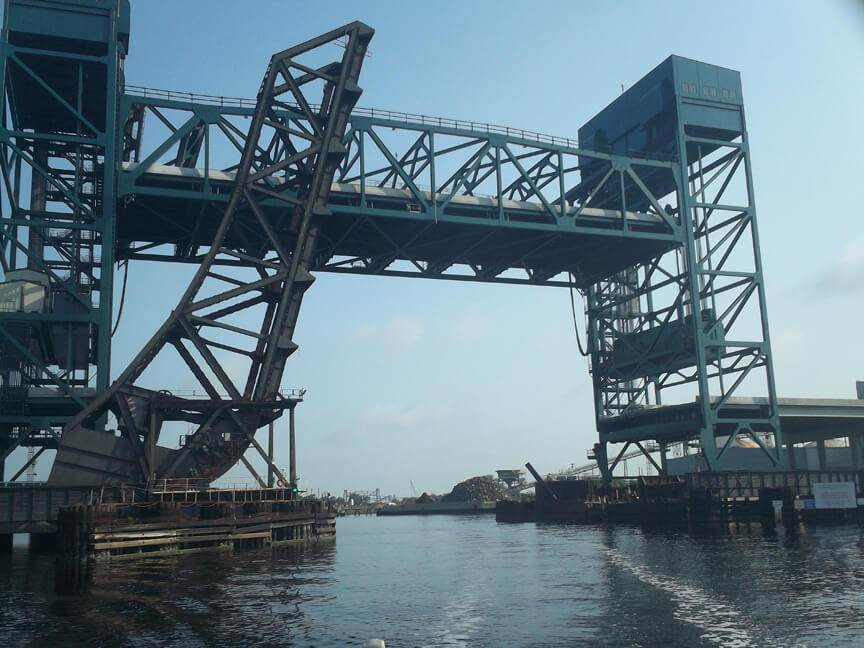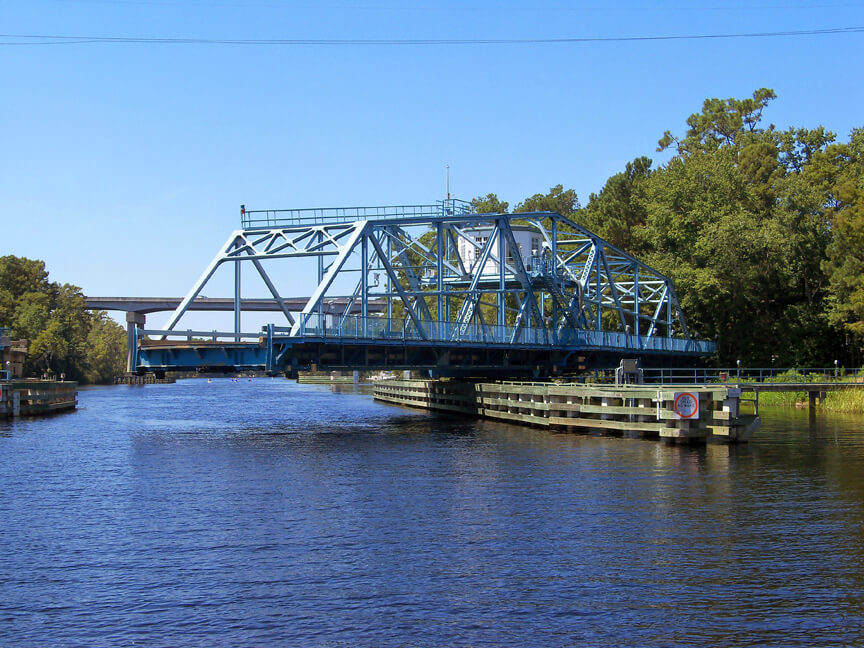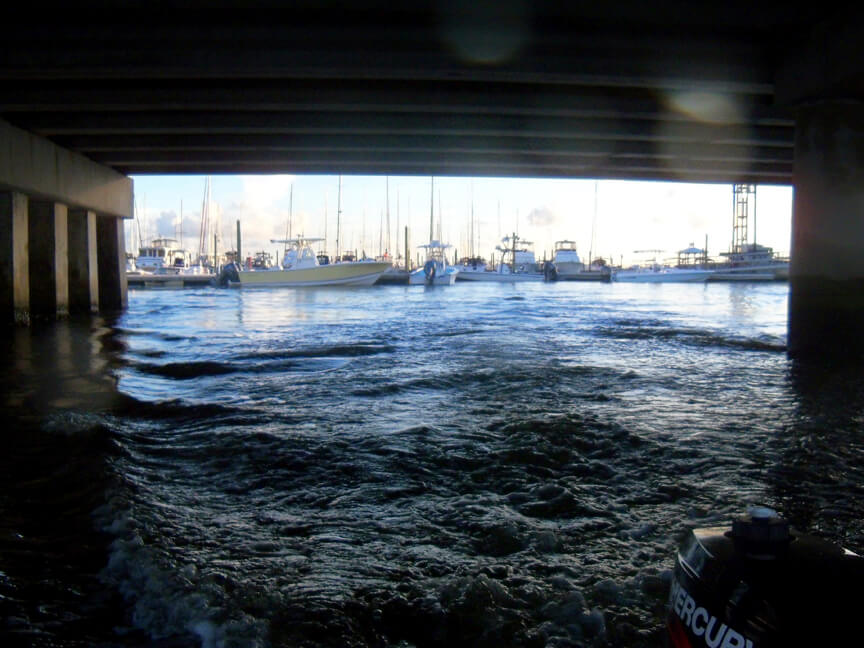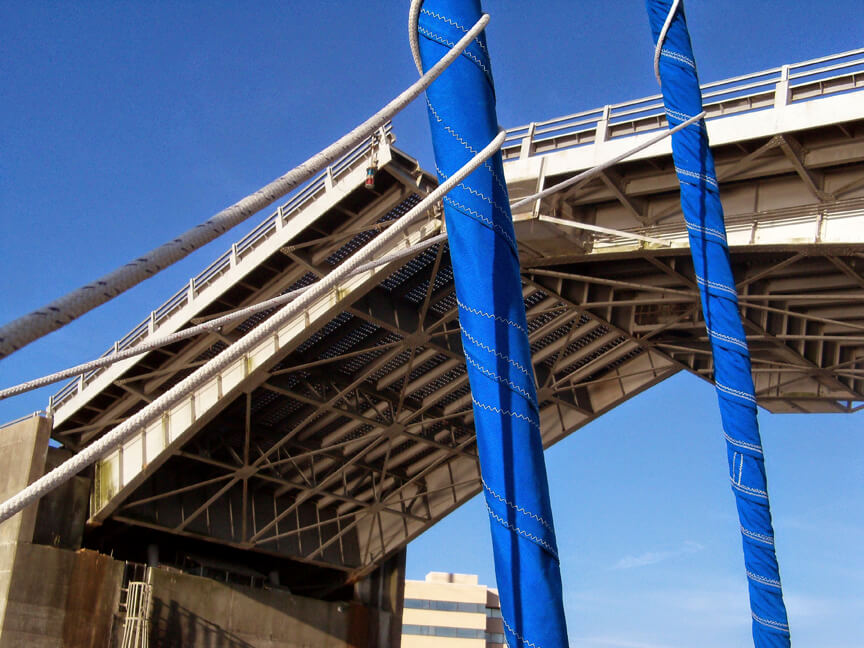Throughout the summer on Long Island Sound and the Chesapeake, we never had reason to call for a bridge opening. However, that all changed abruptly on our first day out of Norfolk when we passed through nine drawbridges. As we continued south, we encountered drawbridges regularly, with, by my count, 21 of them between Norfolk, Virginia and St. Mary’s, Georgia. In each instance, the bridge tenders were friendly and we had few issues contacting them or getting openings. This was a welcome relief because most of my previous experience with drawbridges was on the ICW along the New Jersey coast, where, on one occasion, it took us over twenty minutes to finally establish contact with a bridge tender, only to find that they were a remote operator
and had no idea what bridge we were talking about, despite the fact that we were giving them the name printed on the chart and indicated on the sign hanging on the bridge itself. In that case, we did finally get the bridge opened, but it was a nerve-wracking endeavor. South of Norfolk, we did have a few problems at drawbridges along the ICW, but these issues were all, thankfully, minor. But, even though we had no issues there, the regulations at the Ben Sawyer Bridge outside Charleston seemed overly restrictive, prompting me to write the USCG District Commander requesting a permanent change in the opening schedule.
For the uninitiated, passing through a drawbridge is fairly simple. Some bridges have restrictions, opening, for example, only on the hour between 9am and 4pm weekdays, and not at all between 7-9am and 4-6pm because of rush hour traffic. Restrictions are published in a variety of books, including Dozier’s Waterway Guide and Skipper Bob’s Anchorages. However, many bridges open on request 24 hours a day. Regardless of whether they are on a schedule or not, you hail the bridge on the VHF requesting an opening. It seems bridges north of South Carolina monitor channel 13 and those in SC and south monitor channel 9; channels are listed in the guides above and are posted on the bridges themselves. We usually call when we are about a half mile to a mile out just to make sure we have the regulations correct. The bridge tender will either indicate they will be opening for you or explain that there will be some sort of delay, such as for approaching emergency vehicles. He or she might also ask your hailing port and vessel name, presumably for recordkeeping. Usually the bridge tender times the opening perfectly, going into the long semi-automated opening routine – sound the warning signals, drop the multiple gates on the roadway, and begin raising or spinning the bridge – so that the bridge opens right when you are within a safe but close distance, maybe 20 boat lengths, from the bridge. After successfully navigating past the bridge, I usually give a quick call thanking the bridge tender, which is usually returned with a kind, “You have a good day too, Cap.”
Our first difficulty with a bridge, which was hardly even noteworthy other than that it was funny, came at Onslow Beach, as Tim and I made our way through Camp LeJeune. The bridge is on a restricted schedule, opening on the hour and half-hour between 7am and 7pm. When we were about a half-mile away and approaching the hour, I made a call to the bridge tender and got no response. After a couple more hails with similar results, we found the telephone number for the bridge in a guidebook and gave that a ring, still failing to connect with anyone. As we finally got up to the bridge, we made the sound signal requesting an opening, one long blast followed by a short blast on our horn. When that had no effect, we turned around and brought out speed down. Talking over what our options were at that point, Tim suggested that the bridge tender was probably just in the bathroom and would return soon. And, just a few minutes later, there was a call on the VHF from the bridge tender to the sailing vessel north of the Onslow Beach Bridge, meaning us. I responded, and he explained that he was in the “generator room” and could not hear us hailing him, but would give us an opening immediately. For the rest of the time Tim was on the boat, anytime we needed to relieve ourselves, we would just comment that we were going to check on a few things in the generator room. Tim even wanted me to put a sign reading “generator room” on the door to the head.
Several days and many miles later, at the Wappoo Creek Bridge just south of Charleston, we had – or almost had, depending on your perspective – another incident, though this one was not nearly as funny. It was my fault, and the experience certainly reminded me that I must stay alert and not get complacent at every bridge and, really, all the time we are on the water. Leaving the Charleston City Marina on Sunday of Labor Day Weekend, we approached the bridge around 8am, before any restrictions went into place. I called for an opening and the bridge tender responded in typical fashion, saying she would raise the bridge when I got closer. With a strong current pushing us towards the bridge, I kept waiting for the opening routine to begin, but was not seeing any signs. Thinking that, like all the other bridges we had encountered, this one would also open in time for us, I waited to the last moment before slowing down when the bridge failed to open. As the current swept us towards the bridge, I put it in hard reverse while beginning a 180 degree turn to the left. While this was going on and with my view of the bridge obscured by the bimini and dodger, my Dad indicated that the bridge was now opening. Relieved, I put the boat back in forward, albeit without much way on, and steered for the center of the bridge. We made it through, and would have barely made the turn away from the bridge had it not opened, but it sure got my heart racing and, as I already indicated, provided a good lesson in the importance of staying alert and not assuming anything on the water.
The day before we went under the Wappoo Creek Bridge, we passed under the Ben Sawyer Bridge, linking Sullivan’s Island to the mainland, as we made our way into Charleston. As I detailed in an earlier post, there is severe shoaling in the miles north of the bridge, requiring a vessel with our draft to time its approach so as to pass the area at mid-tide or higher. The bridge itself is closed Monday through Friday from 7am to 9am and 4pm to 6pm and opens only on the hour during holidays and weekends between 9am and 7pm. Besides the shoaling, there is not much chance of timing your arrival for an opening given that there are stretches of both opposing and aiding current of various strengths at any given time in the miles above the bridge. Then, when you finally get to the bridge, there is a stiff current in a fairly narrow channel with, at least the time we went through, a large amount of recreational traffic, all making it difficult to circle while waiting for the hourly bridge opening on the weekends. Given that, it seems the bridge restrictions are onerous for boaters, especially because the Ben Sawyer Bridge is not the only means of accessing Sullivan’s Island; a fixed bridge connects Sullivan’s to the Isle of Palms and, from there, provides quick access to the mainland via the Isle of Palms Bridge. Moreover, the Ben Sawyer Bridge has a vertical clearance of 31 feet in the closed position, meaning only larger sailing vessels and the largest of motor yachts and sportfisherman are requesting openings.
Though we had no problems waiting for the hourly opening of the Ben Sawyer Bridge, I can, as I described above, imagine that the restrictions could pose a problem to boats heading south on the ICW. And, as the drawbridge operation regulations in the Coast Pilot make clear, “Anyone may submit a written request to the District Commander for a permanent change to a drawbridge operating requirement.” So, I decided to write a letter to the District Commander of USCG District Seven, which covers South Carolina. The commander will evaluate the request and respond in writing. If you are concerned about safety on the water and looking to make it easier for boats to transit the ICW, you might want to send along a similar letter. Regardless, plan accordingly and be cautious when working your way through the area around the Ben Sawyer Bridge and, for that matter, any bridge.
(The address for Rear Admiral John H. Korn, Commander, Seventh Coast Guard District is USCG Seventh District, Brickell Plaza Federal Building, 909 SE 1st Avenue, Miami, FL 33131-3050.)




